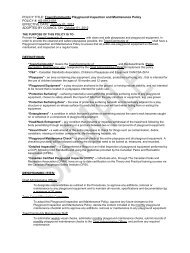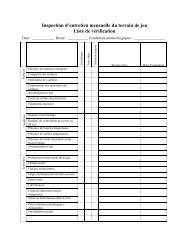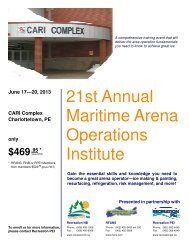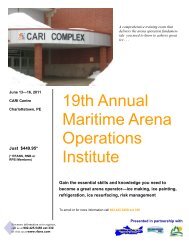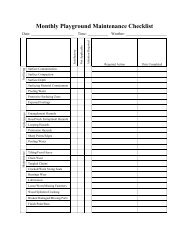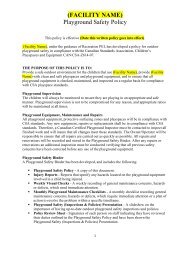Program Manual - Recreation PEI
Program Manual - Recreation PEI
Program Manual - Recreation PEI
- No tags were found...
You also want an ePaper? Increase the reach of your titles
YUMPU automatically turns print PDFs into web optimized ePapers that Google loves.
This supports the rumor that he made glass on Panmure Island. With a large military presence in thearea there was a ready market for alcohol.The terms of the grant specified that the company would bring out 80 settlers with thenecessary stock in 1732 and another 30 in each subsequent year. The settlers would be encouraged toclear the land and construct public and private buildings and of course churches. The company alsohad permission to establish fish-drying facilities on the north shore at Havre St. Pierre (now St. PetersBay) and receive land in proportion to the number of chaloupes (small boats) used for fishing.Jean Pierre Roma was a superb organizer and planner, energetic, ambitious and determined(obsessed?) but to his detriment he also was self-righteous and obstinate in dealing with people. Thisbrought on conflict with partners, government officials and clergy. The problem with the clergy startedwith a dispute over working on Sunday. Fortunately the governor of Louisburg sided with Roma. Onthe surface the future of the settlement looked good but there was a string of difficulties/disasters,some by chance and some due to Roma’s personality, which delayed progress. The success of the colonycan be attributed largely to the detailed planning and scheduling by Roma. He kept meticulous recordsof his accomplishments and activities from which we can get a feel for life at Trois Rivières.About 50 acres of land were cleared and 6000 stumps removed and the hollows filled to makeway for the buildings and crops in the first two years. Later reports indicate about 200 acres werecleared in all. Stumps described as needing 10 to 15 men to move gives an idea of the magnitude of thetask.To protect the point from erosion (still a problem in 2004) Roma leveled the top of the hill onthe point (which was 36ft high) and built up the base with rocks and timber. For cargo handling, heconstructed a pier 45.5ft out from the bank to a water depth of 11 ft at high tide. This required 300tons of stone. A smaller wooden jetty 40ft x 12ft was built for the canoes and chaloupes.Since travel by water was unpredictable in small boats, Roma’s men blazed roads through toHavre St. Pierre (St. Peter’s Bay), Port La Joye (on the Hillsborough River), Sturgeon, Tracadie andBaie de la Fortune. This work was done in the winter with the men staying in temporary shelters builtalong the route.Nine buildings were constructed on the plateau overlooking the water. Two 80 foot buildings,one called the Maison de la Compagnie housed Roma and his family along with a store room and theother accommodated the company’s fishermen. A sixty foot building housed the laborers and visitorsand a second sixty foot one housed the officers and crews of the ships. The supervisors and tradesmenhad a roomy dwelling of 69 feet. One building of 50 feet was partitioned for stores. There was also aforge, a stable and a bake house, each of which was 40 feet. Some of the timbers were dragged acrossthe ice from where Georgetown now stands. The bricks for the 13 massive chimneys and fireplaceswere made on location. Moss and clay were used between the logs of the buildings.Marconi MuseumIn 1998 the Northumberland Community Development Corporation began to develop andrenovate the lighthouse as a tourist facility. It opened to visitors in the spring of 1999. Over 2,000visitors came and with this encouragement, plans were continued to add the Marconi Museum.An annex was added in 1999 to contain a replica of the Marconi Station that stood beside thelighthouse from 1905 until 1924. By the spring of 2000, the annex was completed with an observation



